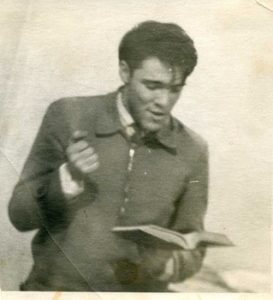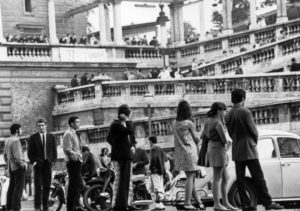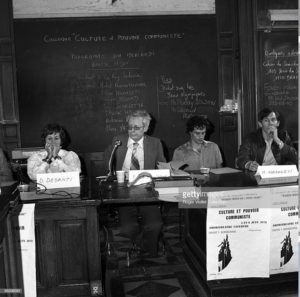In the June 9th 1968 issue of the Hungarian central party newspaper Népszabadság, there is a short news piece hidden on the bottom of page 13:
The Capital Court issued a verdict on Saturday, in the conspiracy case of György Pór et. al. The court found Pór and Sándor Bencze guilty of initiating a conspiracy, and consequently sentenced György Pór to 2 years and 6 months in prison, and Bencze to 2 years in prison. The other accused persons got 6-8 month prison sentences for participating in the conspiracy, among whom some sentences came with 3 year-suspensions. Another suspect was verbally reprimanded by the court. The sentences are not final.
The only thing that is unclear after reading the article is what this conspiracy was exactly about, what did the university student of Russian and History, György Pór, and his accomplices plot? Not a word in public was uttered about this until 1989 and the change of regimes, although János Kádár’s Communist party apparatus continued to use the case to smear and discredit the emerging dissident movement. However, if it did not emerge from Népszabadság what their conspiracy was about, you are now about to find out.
These events that happened 50 years ago made it to the history of Kádár-era Hungary as the “Maoist conspiracy”. Not only was this the label Hungarian state security framed the plotters with, but the expression appeared in the Western press in the exact same form: in the Spring of 1969, the New Statesman reported on the case under the title “The Young Maoists of Budapest” and Süddeutsche Zeitung wrote about how they were “With Mao and Guevara against Kádár”(Articles assembled by Iván Zoltán Dénes).
“In the hot summer of ‘68, we were the tempest in the Hungarian teapot”
In his autobiography titled “The Story of my Introductions”, Gábor Révai, one of the accused in the Maoist case used these words to describe these earlier events. Even as the son of József Révai, the later disgraced chief ideologue of Stalinist Hungarian party leader Mátyás Rákosi, Gábor could not secure a livelihood in the years following his court case, and could only obtain his university degree much later.The fact that he nevertheless described the events as “a tempest in a teapot” in his 2012 book, is not exclusively due to the passing of time. Surely enough, we cannot speak of a real political conspiracy: what happened can be best described as activities of a circle of a few dozen (50-70) university students who often talked about politics. The core of this company was a mere 10-12 people.

Its origins can be traced back to around 1963-64, this is when the two later principal convicts, György Pór and Sándor Bencze met, as the latter was also a student at the Faculty of Humanities at ELTE University. From 1964 on, there was a friendly group of left-wing student youth that, disillusioned with the official Communist Youth movement (KISZ), initiated its own clandestine debates on politics and art, listened to music and collected alternative readings on Marxism.
This society of friends had mostly fallen apart by 1965, but many of its former members participated in the 1966 founding of the Solidarity Committee, the principal activity of which was to show support for Vietnam, at the time under US invasion and attack. They performed social work, bought “solidarity stamps”, organized “Vietnamese Sundays” and distributed their own leaflets in front of the US pavilion of the 1966 Budapest International Fair, as well as calling snap demonstrations in front of the US Embassy.
As it oftentimes pushed the boundaries of the official line, the KISZ chapter at ELTE University disbanded the committee in December 1966, and expelled its leaders from the the organization. György Dalos, one of the members of the “conspiracy” who received probation described the objectives of their “propaganda activities” as: “to show more support for Vietnam fighting the United States than the lukewarm KISZ could. […] The Vietnam-related and other direct actions (such as the illegal protest against the right-wing military junta of Greece on Mayday, 1967) were directed by a narrower, group of conspirators – […] later describing itself on a November 1967 leaflet as “Hungarian Revolutionary Communists”. Around the same time, they assembled a 36-point manifesto of their own, the 34th point of which was to ‘violently overthrow the revisionist, Bourgeois-bureaucratic system’ and replace it with ‘socialism with Chinese characteristics’ in Hungary.”
Dalos’ memoirs also reveal that this narrow core group sustained contacts with a similar Greek refugee organization in Hungary that they met through the Chinese Embassy, as well as with artists “criticizing the official line of the Hungarian Socialist Workers’ Party from an ultra-left point of view.”
Because of their leafleting and the intention to organize a party, a state security enquiry was launched against the group in the autumn of 1967, Pór was arrested on 23 January 1968 and Bencze was detained on January 27. Also arrested were Péter Simon, student at the University of Economics and István Malgot, a student of sculpture at the College of Applied Arts. Court hearings in the case were held throughout May and June and despite the relatively harsh charge of “organizing to endanger the state order” – according to Dalos “sentences were relatively mild.”
Out of the group, only three people actually ended up behind bars: Pór, for two and a half years; Bencze, for two years; and Simon for eight months, and their sentences were later reduced to a third. The other convicted participants – Dalos, Gábor Révai, Tibor Gáti, István Malgot and Judit Gáspár received three-year suspended sentences of a few months each.
Participants of the “conspiracy” broke ties with “Maoism” in this same year, and many of them could be recognized in an entirely other type of political dissident movement a few years later. It is safe to say therefore that Hungarian “Maoism” only existed for a few years in the sixties, mostly in the exclusive circle of Budapest university students. It is interesting, nevertheless, to examine what their “Maoism” did mean, and what the intellectual-political environment was in which it arose for a brief period, before other currents finally took over.
“Our misunderstanding was that of those revolting against power, not that of its accomplices.”
To this day, 1968 lives on in historical memory as the year of global revolution. Many new leftist ideas and movements reached their zenith then, characterized by enormous mass demonstrations and intellectual renaissance, and some of this seeped across the closed closed borders into Hungary.

Besides the most popular of such cultural novelties – beat music – it was the heyday of more marginal currents, such as the cult of Che Guevara. Even the Cultural Revolution of Mao Zedong found some followers (of course these followers were completely unaware of the deadly face of that revolution at the time). This was the era, when leftist critique against the Kádár-regime, which self-identified as leftist,was probably the strongest, condemning the actually existing system from the point of view of socialism. In Hungary, 1968 was also the year the NEM, the New Economic Mechanism; a set of market economy reforms in the system, was introduced. This not only angered the party-state’s ultra-left faction of “workers’ opposition” (Zoltán Komócsin, Béla Biszku), but also left-wing student groups dropping out of KISZ in the 1960’s. They had already criticized the post-1956 Uprising order of “frigidaire-socialism” and evaluated it as a step towards capitalism.
Maoism was deemed an intolerable heresy within the Soviet bloc due to the gradually escalating post-1956 diplomatic conflict between the USSR and the People’s Republic of China. Vigilance of Hungarian authorities was further raised by the 1969 Soviet-Chinese border conflict, putting the two Communist countries on the brink of war. The conflict lasted for decades, and made its mark on ideology as well, as the two sides accused each other of “ideological deflection”. In addition, Maoism was one of the strong currents of the Western New Left of 1968, alongside revised versions of Trotskyism. In Hungary, Maoist newspapers and flyers from London, New York could have appeared, and could partially explain why the ideology surfaced there.
Maoism as a label and a worldview orientation could be interpreted, in this context, as a perfect term that could at the time describe or indeed self-describe any political group criticizing the system from the left. Writer Miklós Vámos – then still using his original name, Tibor Vámos – became part of the society of friends as a teenager, but was not involved in the “conspiracy” and the subsequent court case. Asked about the Maoists, he told Mérce:
I am afraid I cause disappointment by stating, that there was no Maoist conspiracy to speak of. There was however a university student group of 50-70 people, who at the middle or the end of the 1960’s felt that our country’s Socialism was not good enough. They did not want to overthrow the system, but to repair it. Authorities however did not tolerate unsanctioned organization even if it was socialist in nature.
Maoism therefore primarily served as an ideological tool within the bi-polar system of the Cold War, through which criticism could be articulated with regard to both existing capitalism and exisiting socialism. In his opening remarks at a 2001 Budapest exhibition of the posters of the Chinese Cultural Revolution, Miklós Haraszti – a writer also connected to this society of friends through a multitude of contacts, although not involved in the ‘68 court case, not even as a witness – summarized ideas that Hungarian “Maoists” held about the events in China as follows:
Activists as well as the behavior of the leader represented an unusual new quality. But the enemy of choice was unusual as well: the “New Class”, the members of the Communist nomenclature. The principal statement in connection with them was a fundamental truth: they are abusing power and they are lying. All this described our reality. […] By then, Soviet power already became a restorative power in Europe. For us, Maoism covered up anti-Soviet and anti-bureaucracy sentiments, just as Trotskyism played the same role in the West and in Poland. The youth hated the gaping hole existing between beautiful ideas and reality, and thought the whole Cultural Revolution was about that too. Our misunderstanding was that of those revolting against power, not that of its accomplices.(Speech delivered at the Galeria Centralis of OSA Archivum, Budapest, 18 February, 2001. Transcript provided for Mérce by Miklós Haraszti.)
Haraszti also added that Maoism was received in Hungary mainly as a Western influence, an important tool in the arsenal of counter-cultural resistance of the 1960’s. “Long hair, Eastern philosophy, the part guerilla, part peasant and part teacher Mao-jackets, and endless guitar music together served both against the Western bourgeois and the Eastern functionaire.”

The fact that Mao’s Cultural Revolution” resembled more a Stalinist purge than a real gesture of emancipation, and the real meaning of this event for China only became clear later. But by then the protagonists of the story had abandoned any “Maoism” whatsoever already long before. This was in part due to the court case, but largely due to the Warsaw Pact military intervention against Prague’s 1968 “Spring”. That event made it ruthlessly clear once again that an inner reform of the system based on its own ideals was impossible in Soviet-style regimes.
“What would happen if Maoists were to take power?”
Many of the ex-Maoists never gave up revolting against Kádár’s regime and the stigma of “Maoism” stayed with them and their activities for a long time. In 1969, two “youth assemblies” were held in a single year: one was the Conference of Young Writers in the hotel resort of Lillafüred, and the other a Faculty Assembly of Humanities at ELTE University. Both demanded more democracy from those in power, and Haraszti, and a few of the former “plotters” played significant parts in organizing both gatherings.
In 1970, Haraszti and György Dalos were put under police surveillance, ordered not to leave Budapest and sometimes put under house arrest. In protest – inspired by Thoreau and Mahatma Gandhi – the two initiated a civil disobedience action. This led to their arrest in 1971, and to their 25-day hunger strike in the Baracska prison facility. Following the Humanities Faculty Assembly, Haraszti was expelled from the university. As a result, he had to find a job, and started working at the Ganz-MÁVAG Vörös Csillag Tractor Factory. His time there inspired Haraszti to write his most well-known sociography, “Darabbér” (“Piece Rate”) about his experience as an exploited worker in a socialist factory. This raised the authorities’ anger once again. Manuscripts of the book were confiscated by the police in 1973, and in May, Haraszti was again arrested, and was freed only following his two-week hunger strike.
In the scandals following the Faculty Assembly as well as “Darabbér” the recurrent accusation of “Maoist” heresy by state security and the Party had a strong presence. In 1971, Hungarian Marxist philosopher Georg Lukács initiated an exchange of letters with Chief Party Secretary János Kádár to lobby on behalf of freeing Haraszti, and others. Both in his letters to the party leadership and to Lukács, Kádár never failed to bring up the “Maoist” past of the accused, eventually prompting even Lukács to cave in to official Party interpretation in his reply: “I repeat that I do not agree with the Maoist ideology of the aforementioned, and I condemned this ideology in the world press before”- Lukács wrote in his letter of 15 February 1971, even while by this time the young dissidents in question had not only abandoned their previous Maoist views but were also more and more distanced from the New Left and ever closer to Liberal criticism of the regime on the basis of human rights and the rule of law.

Maoism however proved to be a perfect stone to kill all birds, and resurfaced often during the 1970’s to stigmatize and isolate dissident organizations. The quote featured in the subtitle originates from György Aczél, the all-powerful head of cultural policy of the era, and serves the same purpose. “In any case he could not understand why we turned to Lukács, given that if we were to be in power, we would send Lukács to prison within ten minutes” – this is how György Dalos recalled the words of Aczél, when the two met before Dalos’s 1971 prison sentence. (See: Ervin Csizmadia, A magyar demokratikus ellenzék. 1968-1988.) As the post-1990 Hungarian political right adopted a series of false accusations by the Kádár-regime against 1956 Uprising – albeit the postsocialist Right gave a positive spin to what the old regime condemned – so did the emergent far-right continue to use “Maoism” as a smear in the 1990’s, against liberal intellectuals gathering in the Alliance of Free Democrats (SZDSZ).
Magyar Fórum, a far-right weekly directed by István Csurka, published the article “Apák és fiúk” (“Like fathers, like sons”) in March 1990, meant to draw family connections between the old nomenclature and the new generation of Hungarian liberals. The article claimed that Miklós Haraszti (by the time, a prominent member of SZDSZ) once “stood before court accused of Maoist conspiracy”. This was a false statement in light of historical facts, but doubtless a very useful rhetorical turn crafting the stubborn Hungarian myths of the “stolen regime change of 1989” and “communist-liberal continuity”.
Agitators
However minuscule the whole “Maoist conspiracy” of Hungary therefore was in the history of dissident movements against Kádár’s regime, its shadow proved to be long enough to cover whole decades. Through its history, we are offered a unique view of New Leftism, and a window to the hidden “Hungarian ‘68” with its anti-authoritarian, anti-imperialist Romanticism, peppered with the cult of Che Guevara and Chairman Mao, and books of Herbert Marcuse and Angela Davis. This New Left gradually faded away in the context of other, stronger ideological tendencies of Hungarian dissidents (eg. the so-called “Lukács-grandkids” and their Budapest School of philosophy, or the agrarian populists), its significance however was not exclusively political.
This same new-leftist environment helped to create such milestones of Hungarian culture as the very ‘68-ish – but actually made in 1969 – film “Agitátorok” (“Agitators) directed by Dezső Magyar. The script was based on the novel ‘Optimisták’ (“Optimists”) by Ervin Sinkó, and interviews with other participants of the 1919 Bolshevik revolution of Hungary, such as Georg Lukács. “The concept of the film was that main roles of the bourgeois intellectual-turned-Communist agitators would mostly be played by the young leftist intellectuals of the present – as in the 1960’s.” – Gábor Révai remembered. He too played his part, acting as his own father, József Révai, a young Commissar in 1919. Miklós Haraszti, in turn, described “Agitátorok” as a “youthful school yearbook of the ideological underbelly in Budapest”. Magyar’s film, which pushed the boundaries of both political and cinematic language at the time, was banned from public screenings in Hungary until 1986. This same cultural environment fostered the appearance of “pol-beat”, as a musical style, with representatives as the band Atlantis, singer József Dinnyés, or the band Gerilla featuring Tamás Berki and Tibor (Miklós) Vámos (most of whose lyrics were written by Haraszti). But the puppet-theater, music-band and theater assembly Orfeo also had Maoist origins.
(This article was first published by the independent Hungarian website, Mérce.hu. Besides already referenced material, the following books were used: 1968 Magyarországon – Miért hagytuk, hogy így legyen? by Tamás Murai and Eszter Zsófia Tóth, as well as Europe’s 1968: Voices of Revolt edited by Robert Gildea, James Mark and Anette Warring. Szilárd István Pap is the editor of the independent Hungarian website, Mérce.hu. )

